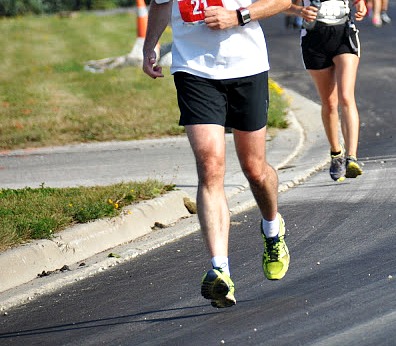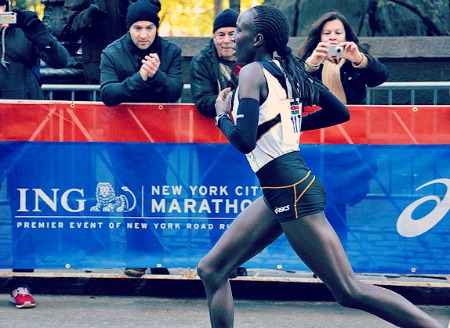Winter running can be dangerous, for a heel strike runner, but not for a forefoot runners. Why?
The reason a forefoot strike runner can run without slipping on ice is due to their torso position (center mass) at the time of foot strike.
The orientation of the center of mass (COM) relative to initial foot strike position makes forefoot running a definitive recommendation for safer winter running.
The position of the COM in forefoot running prevents the incidence of slipping during winter running compared to heel strike running. How?
Forefoot runners (shown above) maintain a forward position of the COM which favors forward oriented forces that prevents slipping.
Winter Running: Do it with Forefoot Running
A forward position of the COM results in a more posterior foot strike position relative to the COM. This means that foot strike position is close to the COM and not in front of it as in heel strike running.
Why Heel Striking is Unsafe for Winter Running
At heel strike, a braking force is applied to the ground which results in a forward weight shift where the amount of forward weight shift depends on how fast the heel striker is running because the braking force increases with speed in heel strike running.
And, remember that under the principles of physics, slipping is a function of braking.
During braking at heel strike, the forward weight shift moves the COM forward and compresses the planted leg that is maximally extended in front of the body. If this occurs on ice, the planted leg is destabilized by the forward weight shift and the COM thereby causing slipping.

In running, slipping is not dependent on the nature of the road surface, it is actually dependent on discrete biomechanical parameters.
In heel strike running, the body is subjected to greater braking and torque than forefoot running whereas the forward oriented body positions associated with forefoot running create ‘steady state conditions’ in the context of winter running.
Why Forefoot Runners Don’t Slip
To run without slipping in forefoot running, the COM must be moving in a straight line with initial foot strike position, that is the COM must be aligned over foot strike position to diminish destabilizing forces that would cause slipping.

Tilting the body forward optimizes the forward orientation of the COM in forefoot running which is effective for maintaining forward momentum and also allows for a highly passive interaction between the body and the ground.
More on Forefoot Running:
- How Forefoot Running is More Efficient
- Longer and Harder Training with Forefoot Running
- Forefoot Running More Comfortable Running Fast than Slow
- Forefoot Running Allows For a Smoother Ride
- Being Heavier Does Not Make You Run Slower, the Wrong Foot Strike Does
Bretta Riches
BSc Neurobiology; MSc Biomechanics candidate, ultra minimalist runner & founder of RunForefoot. I was a heel striker, always injured. I was inspired by the great Tirunesh Dibaba to try forefoot running. Now, I'm injury free. This is why I launched Run Forefoot, to advocate the health & performance benefits of forefoot running and to raise awareness on the dangers of heel striking, because the world needs to know.
Latest posts by Bretta Riches (see all)
- Does Foot Strike Really Matter in Running? YES! - 17/04/2024
- Heel Lifts Increase Injury in Runners - 16/04/2024
- Are Minimalist Shoes Good for Seniors? YES! - 14/04/2024

Leave a Reply